14 The Afterlife in context
Stanley Su
What is the Terracotta Army?
The Terracotta Army is a collection of terracotta sculptures depicting the armies of Qin Shi Huang, the first Emperor of China. The sculptures were buried with the emperor in 210–209 BCE with the purpose of protecting him in the afterlife. The Terracotta Army is considered one of the greatest archaeological discoveries of the 20th century, and it has become a symbol of China’s ancient civilization.
The purpose of the Terracotta Army was to protect the emperor in the afterlife. The sculptures were buried with the emperor in his mausoleum, and they were intended to serve as his personal army in the afterlife, defending him against any threats. The Terracotta Army was also a symbol of the emperor’s power and wealth, and it demonstrated the vast resources that were available to him.
What does the Terracotta Army tell us?
There are certain characteristics that the Terracotta Army has:
- Uniqueness of individual warriors
- Great amount in number
- Close representation of a real person
From these features of the Terracotta Army, we know that it shows the superb work of art and sculpture in China 2000 years ago. Apart from the superficial aesthetics of the Warriors, there are also cultural inferences. For one, it shows the value and belief of the “Afterlife” in ancient China, since whatever is buried with the emperor “follows” him into the underworld. For another, it indicates the supremacy of the emperor in ancient China, as he could command thousands of people to spend years just to build him a tomb.
We could make say that the Terracotta Army tells us
- The craftsmanship of China 2000 years ago
- The belief in the Afterlife
- Supremacy of the emperor
Let’s use these three indicators of guidelines as we go through this chapter.
The Terracotta Army in Xi’an
After the Terracotta Army was found in Xi’an, they have been on display with other Terracotta Warriors in the original pit they were found in. There are approximately hundreds to a thousand Warriors of different positions and features in a single pit which is how they would have been in the Mausoleum of the first Emperor of China. We not only see the spectacular of the Terracotta Army but also the display of a traditional Chinese tomb of an emperor.
Now we should look back at the guidelines. The amount and uniqueness of the warriors do show the great craftsmanship of the Qin dynasty. Moreover, the structure and display of the mausoleum show that the emperor is trying to reconstruct his palace in his reign in his afterlife which also shows his importance as an emperor – the ability to command an army of soldiers and also own all these treasures.
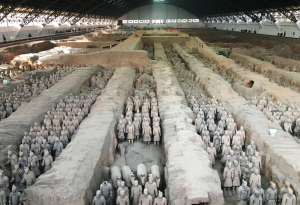
Cases Studies of the Exhibitions around the World
The Metropolitan Museum of Art – “ Age of Empires”
After checking out the museum in Xi’an, we travel around the world to see what the Terracotta Warriors are like in foreign countries. We first start with looking into the temporary exhibition at the MET which is one of the most popular and well-known in the US.
Here is a video description of the exhibition: https://www.youtube.com/watch?v=b8BOWr0OzYY
The title of this exhibition is “Age of Empires”, which focuses on the Chinese Arts of the Qin & Han dynasties. This gallery consists of a combination of different kinds of artifacts, mainly from 32 different museums in China. The exhibitions include “Birth of a Unified China”, “Consolidation of the Empire” and “One Nation, Many cultures”
. The purpose of these exhibitions is to construct a linear timeline from the first Emperor of China. From the descriptions and objects on the display of the exhibitions, it is obvious that artifacts are classified through different time periods.

(Photo of a Terracotta Warrior on display)
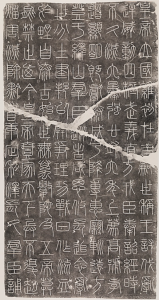
In detail, we examine “The Qin Dynasty: Birth of a Unified China”, which contains the Terracotta Warriors. There are certain artifacts such as calligraphy and decorations in the Emperor’s Palace which indicate that the Emperor “instituted policies such as the standardization of weights, measures, coinage, and, above all, the written language, creating a universal Chinese script”. However, it does not seem to show how impressive the Terracotta army is as one of the eight wonders of the world, since the single warriors are isolated from each other and lack comparison.
(An example of the calligraphy works on display showing the universal Chinese script during the Qin dynasty)
In view of our 3 indicators, we only see the supremacy of the emperor from this exhibition. I believe the problem is that the exhibition does not provide each Terracotta Warrior with enough context. For example, we do not have enough cultural context to understand what do people believe in the afterlife in ancient China. Although there are talks on the topic “Comparisons and Interactions between East and West in antiquity”, the topic does not offer much extra understanding of the antiquities’ cultural background and most visitors do not go to these symposiums. There should definitely be better approaches that give the audience a better experience.
Melbourne, National Gallery of Victoria
In this exhibition, there are multiple sections including “ritual and ceremony in ancient China”, “the first emperor and unification of China”, “ From Human and animal sacrifice to symbolic objects”, “Terracotta Warriors” and some other artifacts as well as modern art pieces. These themes seem to build up a decent cultural background for the Terracotta warriors, for instance, artifacts considering the unification after the first emperor who is the owner of the Terracotta Army, such as bronze coins and caligraphy indicating the writing system. Moreover, from the transcript of the guidebook, we can see that there are many details and historical backgrounds in the description. They introduced the importance of centralization in ancient China and even cited the source “Shiji” by Chinese historian Si Maqian born in 145 BC. They also emphasized how ancient Chinese people valued the importance of the afterlife in different eras. For instance, during the Qin dynasty, the mythical beasts at the gate of the mausoleum “fend off evil spirits and marauding humans”. Similarly, we can speculate that the Terracotta Warriors also serve the same purpose. On the other hand, during the Han dynasty, when family and agriculture thrive, the burial objects include roosters, pigs, and cows.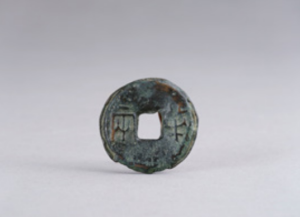
(Photo of a coin from the Qin dynasty on display)
When we revisit the 3 themes of the Terracotta Army, we realize that all of them seem to be satisfied, since the details do provide adequate cultural context for the Terracotta Warriors. However, the fact that an individual Terracotta Warrior is standing in a display box is not very optimal. There is still much that they could do to improve this exhibition. For instance, the work of the modern artist, which is quite unrelated, could be replaced with more related artifacts that help with the audience’s understanding.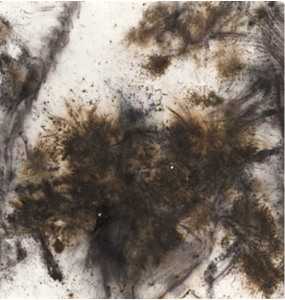
(The modern artwork in the exhibition)
The Museum of New Zealand
There is not a lot of description online about this exhibition but something that stood out to me was the description was in both Chinese and English on the websites, which would attract more non-native English speakers or Chinese people abroad to this exhibition. I believe this could benefit the audience since more people from the country these artifacts are from could create a cultural context for most of the audience.
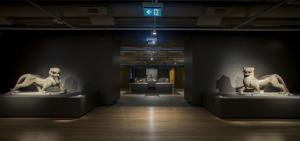
Compared to other exhibitions of the Terracotta Warriors, this website has actual photos of how they display the exhibition. At the entrance of the exhibition, they displayed two statues of mythical creatures on each side, which is quite similar to that of the mausoleum. The intention to recreate entering the mausoleum is very intriguing and immersive. Moreover, they place multiple Terracotta Warriors in one display box, which resembles the original state of the army, but is shy in numbers. Although the space is limited and it is impossible to ship more of these statues abroad, there is a technology that people could use to increase the amount of Terracotta Warriors on display.
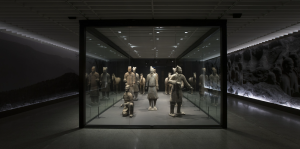
How to resolve this?
From the examples above, we see that each of the exhibitions are lacking the basic cultural background to understand the exhibits. It is easier to construct the historical background by placing artifacts in the same time period adjacent to each other. Due to the limitedness of size and amount of artifacts on display, it is hard to get the audience fully immersed. However, we do see some interesting features that could be applied to the solution.
- The cultural context provided by related artifacts and adequate description
- Bilingual content that attracts more non-native audience
- Display that resembles the Terracotta Warriors’ original state
- Symposium that provides more explanation
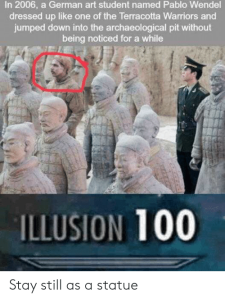
In addition to these observations, I got inspiration from the lecture of Professor Bryan Burns and my friend Max. The talk of Professor Bryan Burns made me realize how technology could be used to preserve artifacts or archeological sites. I was convinced that this technology could be used for more purposes than simply preserving archeological sites for archeologists and instead towards the public. My friend Max also shared with me the story where his grandparents bought a life-sized Terracotta Warrior figure made to look like his grandfather.
I propose that the exhibition should for one, be targeted towards audiences of all backgrounds, including non-natives who would have more understanding of the exhibition. Furthermore, the exhibition could share some resemblance of the Terracotta Army in the mausoleum with similar structures and related artifacts, such as mythical creatures and weapons, as well as lining the Terracotta Warriors together so that the audience could appreciate them as a whole. Moreover, they should design adequate descriptions for the artifacts that describe their provenance and history as well as some cultural phenomenon in accordance with it. The symposium is an additional highlight that adds academic professionalism to the whole exhibition. They should also include technology such as VR that allows audiences to visit the Terracotta Army as if they were in the pits in Xi’an rather than a simple display box with an audio guide with stories of its discovery as well as the history of the first emperor. Another interesting feature that they could add is a face scanner that allows a monitor to generate a Terracotta Warrior that looks like the person whose face is scanned. Through this process, the audience could see how the Terracotta Warrior is made at the same time while appreciating the spectacular craftsmanship in China 2000 years ago and understanding the uniqueness of each Terracotta Warrior.
References
- Jiang, Fercility. “Terracotta Army Overseas Exhibitions 2010-2020.” China Highlights, 12 November 2021, https://www.chinahighlights.com/xian/terracotta-army/exhibition.htm
- “Terracotta Warriors: Guardians of Immortality.” Museum of New Zealand, https://www.tepapa.govt.nz/about/past-exhibitions/terracotta-warriors-guardians-immortality
- “Terracotta Warriors and Cai Guo-Qiang.” Melbourne National Gallery of Victoria, https://www.ngv.vic.gov.au/wp-content/uploads/2019/06/NGV_Terracotta-Warriors-Cai-Guo-Qiang_Multimedia-Guide-Transcript.pdf
- “Age of Empire: China Art of Qin and Han Dynasties.” Metropolitan Museum of Art, https://www.metmuseum.org/exhibitions/listings/2017/age-of-empires
- “Qin Shi Huang Mausoleum.” Travel China Guide, https://www.travelchinaguide.com/attraction/shaanxi/xian/terra_cotta_army/mausoleum_1.htm

